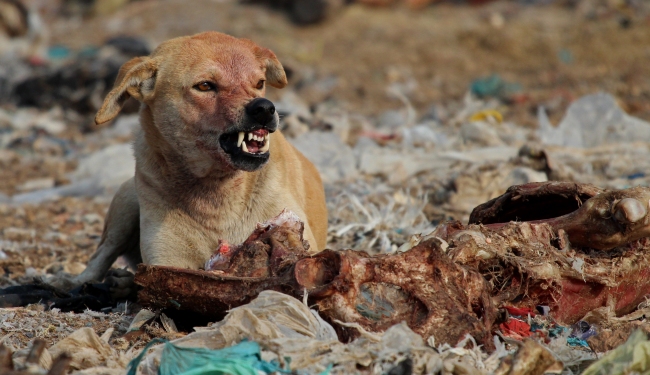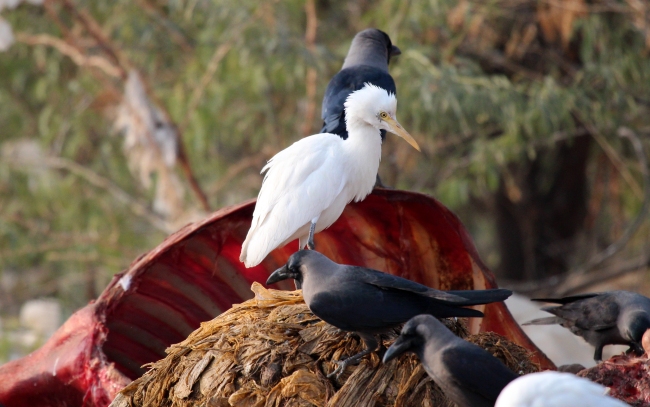Strong dust storms, shifting dunes, and hundreds of cattle carcasses can be found in this remote area of Bikaner. I stood for a long time, amazed at the scene, taking it all in. I wanted to learn more about this fascinating place.
I found out that Jorbeer is a major source of food availability for vultures, about 20-35 carcasses are dumped per day by the municipal board and local townspeople. They are placed here on the outskirts of town to help the dwindling vulture populations.
In the early 1990s, vultures of India and South Asia were among the most abundant large raptors in the world. However, within a decade, the populations of three species, White-rumped Vulture (Gyps bengalensis), Indian Vulture (G. indicus), and Slender-billed Vulture (G. tenuirostris), had declined so sharply that all three are considered Critically Endangered.
Extensive research identified the cause of the decline to be ‘diclofenac’, a non-steroidal anti-inflammatory drug used to treat livestock. Any vultures feeding on the carcasses of animals recently treated with the drug suffered renal failure and died.
I was surprised to find out that cattle, so honored in India, were given drugs. It doesn’t coincide with my picturesque view of cows wandering the streets of India waiting for their chapati. Apparently it was used to treat the symptoms of inflammation, fever or pain associated with disease or wounds.
The loss of vultures resulted in a sharp increase in the number of feral dogs around carcass dumps—the bites of these dogs are the most common cause of human rabies in the region. A 2008 study estimated that, concurrent with the vulture die-off, there was more than a 5.5 million increase in the feral dog population. This resulted in 38.5 million additional dog bites and more than 47,300 additional rabies deaths.
The drug, diclofenac, was banned in 2006, and recent surveys suggest vulture numbers have stabilized in India resulting from this ban. Although the vulture population has stabilized, the numbers remain very low across the region and any recovery will be slow.
Seven different species of vultures have been recorded here in Jorbeer; however, I only observed the Egyptian vulture (Neophron percnopterus) during my visit. This vulture is classified as an Endangered species and is a year round resident of this area.
Egyptian Vulture.
Steppe and Tawny Eagles
Feral Dogs
Indian House Crows
Indian Cattle Egret
The scene
These young men live on the outskirts of the dumping area. They skin the carcasses and make leather products from them. They sell these products to help provide income for their families.
I would like to thank Indrajit Ghorpade for telling me about this place, and for helping me correctly identify the birds located at this site.
































Hi! Lovely writeup 🙂 Just a small nitpick. Most of the eagles in your images are Steppe Eagles (Aquila nipalensis). Note the gape line which reaches almost to the end of the eye, pale chin and the broad underwing bands. The Tawny Eagle will have the gape line reaching the middle of the eye and will not show the broad white underwing bands
Cheers!
Chinmay! Thank you. I knew they were eagles by their faces, but had to rely on someone else to tell me what kind! I will look at them today and try to sort them out. I may ask for your help!
Thanks again.
Om shanti,
Roberta 😀
This is so good … excellent shots nice write up …. so intense
Thank you Kaushik! 🙏🏼
Our content team at 50/50 found the story of “Jorbeer, India” to be of interest and would like to use the photo’s on an insert on Vultures. This images will then be used in an insert on the environmental programme 50|50 that has been running for over 30 years on SABC. We will be able to credit the photographer at the end of the show, please can we get permission to use these images?
We look forward to hearing from you,
Thank you in advance,
Nicolette
Assistant Content Producer at 50|50
Hello Nicolette, Yes you may use the photos with photo credit. Om shanti,
Roberta
Thank you much appreciated! For the credit is this correct: Roberta Dell’Anno?
Hi Nicolette, Yes Roberta Dell’Anno is correct. 🙏🏼